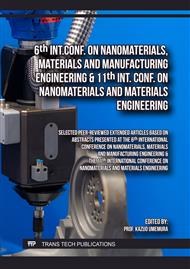p.9
p.15
p.21
p.27
p.33
p.41
p.49
p.59
p.67
Natural Rubber-Based Thermal Insulation Foams: Physical, Mechanical and Heat Insulation Properties
Abstract:
This research investigates the influence of the quantity and type of flame retardants and blowing agents on the thermal insulation properties of foam prepared using STR 20 block rubber. Supercell DPT was employed as a blowing agent, and aluminium trihydroxide (ATH) and chlorinated polyethylene (CPE) functioned as flame retardants, with their concentrations adjusted to 10 and 20 parts per hundred rubber (phr). All rubber compound formulations were prepared via a semi-EV sulphur vulcanization system. The expansion ratio in a compression mould and curing properties of the rubber compounds were determined at 170 °C. The experimental results revealed that increasing the amount of blowing agent from 3 to 8 phr led to a maximum increase of 110% in the pore size within the foam structure. Both ATH and CPE at a concentration of 10 phr are sufficient to make all insulating foam formulations pass the UL-94 HBF flammability test. The natural rubber foam applied with 8 phr of blowing agent and 10 phr of ATH flame retardant exhibited the lowest water absorption at 0.46%. It also demonstrated good durability at a maximum temperature of 84 °C for 7 days, and the lowest thermal conductivity (K-value) of 0.0648 W/m·K according to ASTM C518-10.
Info:
Periodical:
Pages:
33-40
Citation:
Online since:
June 2025
Price:
Сopyright:
© 2025 Trans Tech Publications Ltd. All Rights Reserved
Share:
Citation:



